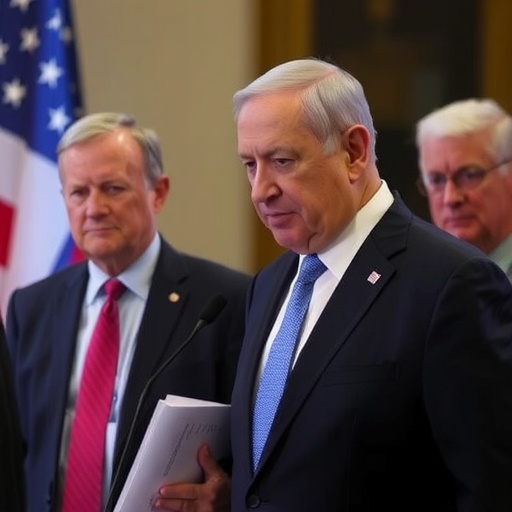U.S. Officials Head to Israel as Netanyahu Issues Ultimatum to End Gaza Ceasefire
In a dramatic escalation of the Israel-Gaza conflict, Prime Minister Benjamin Netanyahu has issued a stark warning to collapse the fragile ceasefire in Gaza, prompting a swift response from top U.S. officials who are now en route to Israel for urgent high-level talks. The move comes amid rising tensions, with Netanyahu accusing Palestinian militants of violating the truce through rocket fire, a claim that has ignited fears of renewed violence in the region.
The announcement, delivered during a fiery speech in Jerusalem on Tuesday, underscores the precarious state of the ceasefire brokered just weeks ago after months of intense fighting. As U.S. officials, including Secretary of State Antony Blinken and National Security Advisor Jake Sullivan, prepare to land in Tel Aviv, international observers are watching closely, concerned that Netanyahu’s threat could unravel hard-won progress and plunge Gaza into further chaos.
Netanyahu’s Fiery Speech Ignites Ceasefire Crisis
Prime Minister Benjamin Netanyahu’s address to the Knesset on Tuesday was nothing short of explosive. Standing before a packed chamber in Jerusalem, he declared that Israel would not tolerate what he described as “ongoing provocations” from Gaza-based groups like Hamas. “If the ceasefire is to hold, it must be respected by all sides,” Netanyahu stated emphatically. “But if violations continue, Israel will have no choice but to respond decisively, even if it means ending this truce once and for all.”
This ultimatum marks a significant shift in tone from the Israeli leader, who had previously touted the ceasefire as a victory for Israel’s security. Sources close to the Netanyahu administration indicate that the decision stems from a series of incidents over the past week, including three rocket launches from Gaza that landed harmlessly in open fields near the border. While no casualties were reported, the attacks have fueled domestic pressure on Netanyahu from hardline coalition partners who demand a tougher stance.
Netanyahu’s rhetoric has deep roots in Israel’s long-standing security concerns. Since the 2005 disengagement from Gaza, the territory has been a flashpoint, with multiple wars erupting in 2008, 2012, 2014, and most recently in 2023. The current ceasefire, mediated by Egypt and Qatar with U.S. backing, was intended to allow humanitarian aid into Gaza and prevent further escalation. However, with over 1.9 million residents in Gaza facing acute food insecurity according to United Nations reports, the stakes could not be higher.
Critics within Israel, including opposition leader Yair Lapid, have condemned Netanyahu’s threat as “reckless posturing.” Lapid argued in a statement that “threatening to collapse the ceasefire only invites more bloodshed and isolates Israel on the world stage.” Yet, Netanyahu’s supporters, particularly from the Likud party, see it as a necessary show of strength to deter future attacks.
U.S. Envoys Race Against Time in Tel Aviv Discussions
As Netanyahu’s words echoed across Israel, a delegation of senior U.S. officials touched down in Tel Aviv on Wednesday morning, signaling Washington’s deep involvement in averting a crisis. Leading the talks is Secretary of State Antony Blinken, who met immediately with Israeli Foreign Minister Gideon Sa’ar at the Foreign Ministry. Accompanying Blinken are National Security Advisor Jake Sullivan and special envoy for Middle East peace Brett McGurk, all tasked with reinforcing the importance of the Gaza ceasefire.
The U.S. team’s agenda is packed: discussions will focus on de-escalation measures, verification of ceasefire compliance, and bolstering humanitarian access to Gaza. “We are committed to the stability of the region and urge all parties to honor their commitments,” Blinken said in a brief statement upon arrival. White House sources reveal that President Joe Biden has personally instructed the envoys to emphasize the risks of ceasefire collapse, including potential disruptions to broader U.S.-Israel relations and the Abraham Accords normalization efforts with Arab states.
Behind closed doors, the talks are expected to address specific grievances. Israel has demanded stricter monitoring of Gaza’s borders to prevent arms smuggling, while the U.S. is pushing for increased aid convoys—over 500 trucks per day, up from the current 200—to alleviate the humanitarian crisis. Data from the World Health Organization indicates that 96% of Gaza’s population lacks access to clean water, a situation exacerbated by the conflict.
The presence of U.S. officials in Israel is not unprecedented but carries added weight given the timing. In 2021, similar high-level visits helped broker a ceasefire after 11 days of fighting. This time, however, the political landscape is more volatile, with Netanyahu facing domestic protests over judicial reforms and corruption trials, adding layers of complexity to the negotiations.
Global Powers Voice Alarm Over Gaza’s Ticking Time Bomb
The international community has reacted swiftly to Netanyahu’s threat, with world leaders lining up to urge restraint and preserve the Gaza ceasefire. United Nations Secretary-General António Guterres called the situation “a powder keg” during a press conference in New York, warning that “any collapse could lead to catastrophic consequences for civilians on both sides.” Guterres advocated for an immediate expansion of the UN’s monitoring role in Gaza, citing the organization’s success in similar peacekeeping efforts in Lebanon.
European allies echoed these concerns. British Prime Minister Rishi Sunak, in a call with Netanyahu, stressed the need for “diplomatic channels to remain open,” while French President Emmanuel Macron announced plans for a Paris summit on Middle East peace next month. In the Arab world, Egypt’s Foreign Minister Sameh Shoukry, a key mediator, labeled Netanyahu’s ultimatum “counterproductive,” reminding Israel of the 1979 peace treaty’s emphasis on stability.
Closer to home, Palestinian Authority President Mahmoud Abbas condemned the threat as “an act of aggression,” calling on the U.S. to pressure Israel. Hamas, the dominant force in Gaza, responded with a defiant statement: “Our resistance will not be silenced by empty threats.” This back-and-forth has drawn sharp scrutiny from human rights groups; Amnesty International reported that since the ceasefire began, over 2,000 violations have been alleged by both sides, though independent verification remains elusive.
Economically, the ripple effects are already felt. Israel’s shekel dipped 1.2% against the dollar following Netanyahu’s speech, per Bloomberg data, while aid organizations like Oxfam warn that a ceasefire breakdown could displace another 500,000 Gazans, on top of the 1.7 million already affected.
Recounting the Rollercoaster of Gaza Ceasefire Attempts
To understand the gravity of Netanyahu’s threat, one must revisit the turbulent history of ceasefires in Gaza. The current truce is the latest in a series of fragile agreements dating back to the 1993 Oslo Accords, which envisioned a path to peace but instead sowed seeds of division. The 2007 Hamas takeover of Gaza shattered unity, leading to Israel’s blockade and repeated cycles of violence.
Key past ceasefires offer lessons: The 2012 truce, brokered after eight days of rocket exchanges, lasted 18 months before fraying. In 2014, a 51-day war killed over 2,100 Palestinians and 70 Israelis, ending in a Qatar-mediated deal that included prisoner swaps and eased restrictions. The 2021 ceasefire followed a similar pattern—intense bombardment followed by quiet, but underlying issues like settlement expansion in the West Bank persisted.
Statistics paint a grim picture: According to the Gaza Health Ministry, the 2023 conflict alone claimed 41,000 lives, mostly civilians, and destroyed 60% of housing units. The current ceasefire, effective since late January, has seen a 70% drop in hostilities, per Israeli military data, but incidents like the recent rocket fire—attributed to Islamic Jihad factions—highlight enforcement challenges.
Experts point to systemic issues. Dr. Sara Roy, a Harvard scholar on Gaza, notes in her recent analysis that “ceasefires without addressing root causes like the blockade and political isolation are doomed to fail.” Netanyahu’s government, bolstered by far-right allies, has resisted concessions, viewing any softening as a security risk.
Amid this history, U.S. involvement has been pivotal. From the Camp David Accords to today’s shuttle diplomacy, Washington has provided Israel with $3.8 billion in annual military aid, per Congressional Research Service figures, while advocating for Palestinian statehood—a balancing act now tested by the ceasefire’s fragility.
Charting the Path Forward: Risks and Pathways to Peace
As U.S. officials huddle with Israeli counterparts, the path ahead remains fraught with uncertainty, but opportunities for de-escalation exist. Netanyahu has hinted at conditional extensions of the ceasefire if compliance improves, potentially tying it to broader talks on Gaza’s reconstruction, estimated at $50 billion by the World Bank.
Forward-looking scenarios include enhanced UN patrols along the Gaza border, a proposal floated by the U.S. delegation, and economic incentives like job programs funded by Gulf states. However, failure looms large: Analysts from the International Crisis Group warn that a collapse could spark a multi-front war, involving Hezbollah in Lebanon and drawing in Iran-backed militias.
Public sentiment adds pressure. Polls by the Israel Democracy Institute show 62% of Israelis favor maintaining the ceasefire, while in Gaza, surveys by the Palestinian Center for Policy and Survey Research indicate 75% support for truce adherence if aid flows freely. U.S. officials are leveraging this, with Blinken reportedly preparing a joint statement on Thursday outlining mutual commitments.
Ultimately, the coming days will test the resolve of leaders in Israel, Gaza, and beyond. With the region’s stability hanging in the balance, the international community braces for what could be a pivotal moment—or a devastating return to conflict.









